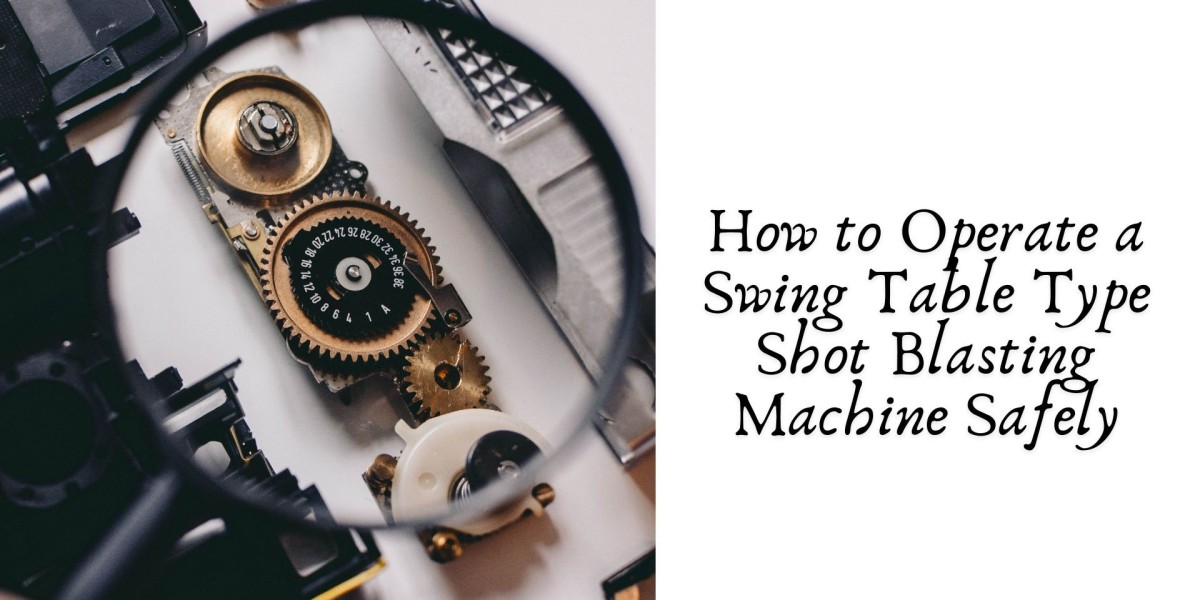Operating a swing table type shot blasting machine requires a comprehensive understanding of the equipment, strict adherence to safety protocols, and diligent maintenance practices. This article provides a detailed guide on how to safely operate a swing table type shot blasting machine, ensuring both effective performance and the safety of the operators.
Understanding the Swing Table Type Shot Blasting Machine
A swing table type shot blasting machine is designed for cleaning, descaling, and surface preparation of metal workpieces. It features a rotating table where workpieces are placed and subjected to high-velocity abrasive media propelled by blast wheels. This machine is commonly used in foundries, forging plants, and various industries requiring surface finishing.
Key Components
- Blast Cabinet: Enclosed area where the blasting process occurs.
- Swing Table: Rotating table that holds and moves the workpieces.
- Blast Wheels: Devices that accelerate and throw the abrasive media at the workpieces.
- Dust Collector: System that captures dust and debris generated during blasting.
- Control Panel: Interface for operating the machine, adjusting settings, and monitoring performance.
- Abrasive Media Hopper: Storage for the abrasive material used in the blasting process.
Pre-Operation Safety Measures
Before operating the machine, it is crucial to perform several safety checks and preparations:
Personal Protective Equipment (PPE)
Ensure all operators and personnel in the vicinity wear appropriate PPE, including:
- Safety goggles or face shields
- Hearing protection (ear plugs or earmuffs)
- Gloves
- Protective clothing (aprons or coveralls)
- Respiratory protection if necessary (dust masks or respirators)
Machine Inspection
Conduct a thorough inspection of the machine to identify any potential issues:
- Check the blast cabinet for signs of wear, damage, or residue buildup.
- Inspect the swing table for smooth operation and secure mounting.
- Ensure the blast wheels are intact and properly aligned.
- Verify the dust collector system is functional and filters are clean.
- Confirm the abrasive media hopper is filled with the correct type and quantity of media.
Workspace Preparation
Prepare the workspace to ensure a safe and efficient operation:
- Clear the area around the machine of any obstacles or unnecessary items.
- Ensure adequate lighting and ventilation in the workspace.
- Mark safety zones and restrict access to authorized personnel only.
Operating the Swing Table Type Shot Blasting Machine
Loading Workpieces
Properly loading workpieces onto the swing table is critical for achieving optimal blasting results:
- Arrange workpieces evenly on the table to avoid imbalance during rotation.
- Secure workpieces with clamps or fixtures if necessary to prevent movement during blasting.
- Ensure workpieces do not exceed the machine’s weight and size limitations.
Setting Parameters
Adjust the machine’s settings according to the requirements of the blasting operation:
- Set the rotation speed of the swing table to ensure even exposure to the blast stream.
- Adjust the blast wheel speed and angle for optimal coverage and efficiency.
- Select the appropriate abrasive media type and size based on the workpiece material and desired finish.
Initiating the Blasting Process
Follow these steps to safely start the machine:
- Close the blast cabinet door securely.
- Start the dust collector system to maintain air quality.
- Activate the blast wheels and slowly start the rotation of the swing table.
- Monitor the process through the control panel and adjust settings if necessary.
Monitoring During Operation
Continuous monitoring ensures safe and effective operation:
- Watch for any unusual noises, vibrations, or signs of malfunction.
- Check the control panel for error messages or warnings.
- Ensure the dust collector is functioning properly and not overloaded.
Ending the Blasting Process
When the blasting process is complete, follow these steps to safely shut down the machine:
- Turn off the blast wheels and allow the swing table to come to a complete stop.
- Deactivate the dust collector system.
- Open the blast cabinet door and carefully remove the workpieces.
Post-Operation Safety Measures
After the operation, perform the following tasks to maintain the machine and ensure ongoing safety:
Cleaning
Thoroughly clean the machine and surrounding area:
- Remove any residual abrasive media from the blast cabinet and swing table.
- Clean the dust collector and replace filters if necessary.
- Dispose of collected dust and debris according to local regulations.
Inspection and Maintenance
Conduct a post-operation inspection and perform any necessary maintenance:
- Inspect the blast wheels, swing table, and other components for wear or damage.
- Lubricate moving parts as recommended by the manufacturer.
- Check the abrasive media hopper and refill if needed.
- Record any maintenance activities in the machine’s logbook.
Safety Review
Review the operation and address any safety concerns:
- Evaluate the effectiveness of the PPE used and make improvements if needed.
- Discuss any incidents or near-misses with the team to prevent future occurrences.
- Ensure all safety protocols were followed and reinforce their importance with all operators.
Training and Continuous Improvement
Proper training and continuous improvement are essential for the safe operation of a swing table type shot blasting machine:
Operator Training
Ensure all operators receive comprehensive training on:
- Machine components and functions
- Safety protocols and PPE usage
- Loading and unloading procedures
- Setting and adjusting parameters
- Emergency procedures
Regular Updates
Stay updated with the latest industry standards and best practices:
- Attend workshops, seminars, and training sessions.
- Keep abreast of new technologies and safety features.
- Regularly review and update safety protocols and operation manuals.
Feedback and Improvement
Encourage feedback from operators to identify areas for improvement:
- Hold regular meetings to discuss operation experiences and challenges.
- Implement suggestions and solutions to enhance safety and efficiency.
- Foster a culture of continuous improvement and safety awareness.
Conclusion
Operating a swing table type shot blasting machine safely requires diligent preparation, careful monitoring, and ongoing maintenance. By following the guidelines outlined in this article, operators can ensure the safe and efficient performance of the machine, protecting both themselves and their colleagues. Emphasizing proper training and continuous improvement will further enhance safety and operational success.



